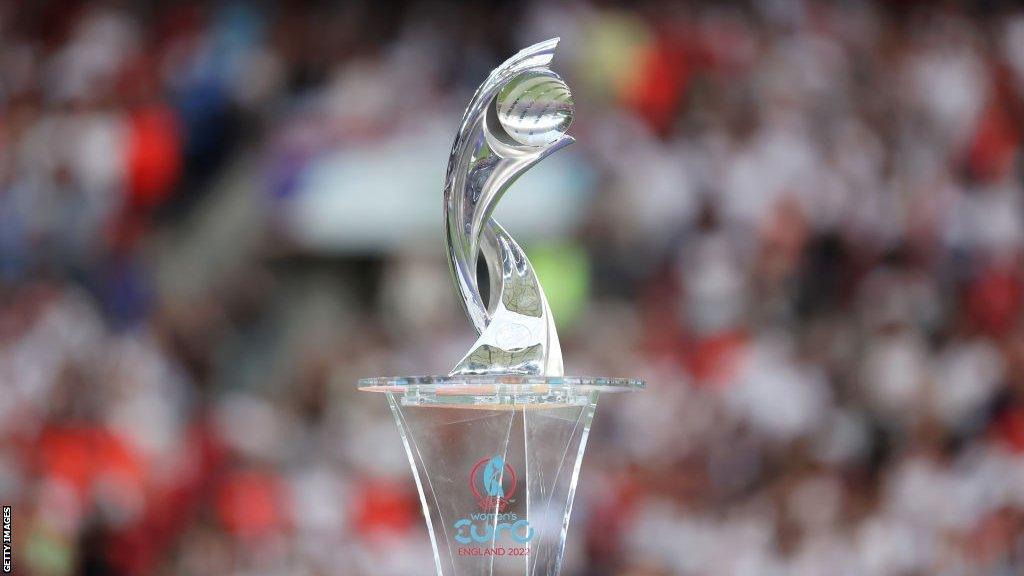Women's Euro 2025 qualifying: England, Scotland, Wales and Northern Ireland discover opponents
- Published
- comments

England are the defending Women's European champions
Holders England have been drawn in a tough group with the Republic of Ireland, France and Sweden in Group A3 of Women's Euro 2025 qualifying.
Scotland will face Serbia, Slovakia and Israel in Group B2, while Northern Ireland are alongside Portugal, Bosnia-Herzegovina and Malta in Group B3.
Wales have been drawn against Croatia, Ukraine and Kosovo in Group B4.
The qualifiers will take place between April and July, with the tournament scheduled for July 2025 in Switzerland.
France, England and Sweden are ranked third, fourth and fifth respectively in the Fifa rankings, while the Republic of Ireland are 24th.
The Lionesses beat Sweden 4-0 on their way to lifting the trophy in 2022.
World champions and Nations League winners Spain will play Denmark, Belgium and Czech Republic.
Germany, who lost to England in the Euro 2022 final at Wembley, will face Austria, Iceland and Poland.
Switzerland, who will take part despite having automatically qualified as the host nation, have been drawn against Hungary, Turkey and Azerbaijan.
The top two teams from the League A groups will qualify automatically, with the other two sides entering the play-offs.
The nations in Leagues B and C are competing to reach the play-offs.
The groups in full
League A
Group A1: Netherlands, Italy, Norway, Finland
Group A2: Spain, Denmark, Belgium, Czech Republic
Group A3: France, England, Sweden, Republic of Ireland
Group A4: Germany, Austria, Iceland, Poland
League B
Group B1: Switzerland, Hungary, Turkey, Azerbaijan
Group B2: Scotland, Serbia, Slovakia, Israel
Group B3: Portugal, Bosnia and Herzegovina, Northern Ireland, Malta
Group B4: Wales, Croatia, Ukraine, Kosovo
League C
Group C1: Belarus, Lithuania, Cyprus, Georgia
Group C2: Slovenia, Latvia, North Macedonia, Moldova
Group C3: Greece, Montenegro, Andorra, Faroe Islands
Group C4: Romania, Bulgaria, Kazakhstan, Armenia
Group C5: Albania, Estonia, Luxembourg

Analysis
Emma Sanders, BBC Sport
The defence of England's title may not be as straightforward as many presume.
They have a tough group which includes Olympic runners-up Sweden, as well as major tournament regulars France.
In the Republic of Ireland, they will come up against Arsenal's Katie McCabe, who helped spearhead the side to their first appearance at the 2023 Women's World Cup.
Sweden has been a hotbed of talent for several years and the Women's Super League has recruited heavily from the Scandinavian region so there will be familiar faces in that match-up too.
England were strong favourites to win Euro 2022 but since then, the quality of opposition around Europe has significantly improved.
Sarina Wiegman's side will need to be at their best and hope they have key players back from injury - including Chelsea duo Fran Kirby and Millie Bright.
They will be boosted by their performances in the recent international camp in Spain, where they recorded big wins over Austria and Italy, and new players thrived on their debuts.
Northern Ireland will be determined to make the most of a draw which gives them a real chance of qualification.
Portugal, with several exciting young players, are expected to be their strongest opponents but NI will fancy their chances against lower-ranked opposition in Malta and Bosnia-Herzegovina.
Scotland, who narrowly missed out on qualification for the Women's World Cup, are the highest-ranked side in their qualification group so will also feel confident.
However, the Scots are without key midfielder Caroline Weir, who suffered an anterior cruciate ligament injury last year.
Wales, under new management in Rhian Wilkinson, have a tough tie with Ukraine, but are capable of topping their group if their key players remain fit and perform well.
How does Women's Euro 2025 qualifying work?
The qualifiers will see each team face the other teams in their group home and away.
Group winners and runners-up from each League A group automatically qualify, with the remaining seven places taken by the best-ranked sides from all three leagues.
All third and fourth-placed teams from League A will go through to the play-offs.
The top three teams in each League B group will also make the play-offs. If Switzerland finish in the top three of their group, then the best ranked fourth-placed team from League B will go into the play-offs.
From League C, the five group winners and three best-ranked runners-up will reach the play-offs.
The 28 teams making the play-offs will be whittled down to seven, with the first round being split into two paths.
The eight sides from League A will be drawn against the eight sides from League C. The six best teams from League B will face the six lowest-ranked teams from League B. Both sets of matches are two-legged.
In the second play-off round, the remaining 14 teams will be split via seedings. The seven nations with the best ranking will be drawn against the other seven teams. The winners of those fixtures will qualify for the finals.

Big laughs and top quality content with Elis and John: Join the UK's youngest and most relevant broadcasters
Can three million people disappear from public memory? This is the story of the Bengal Famine of 1943
